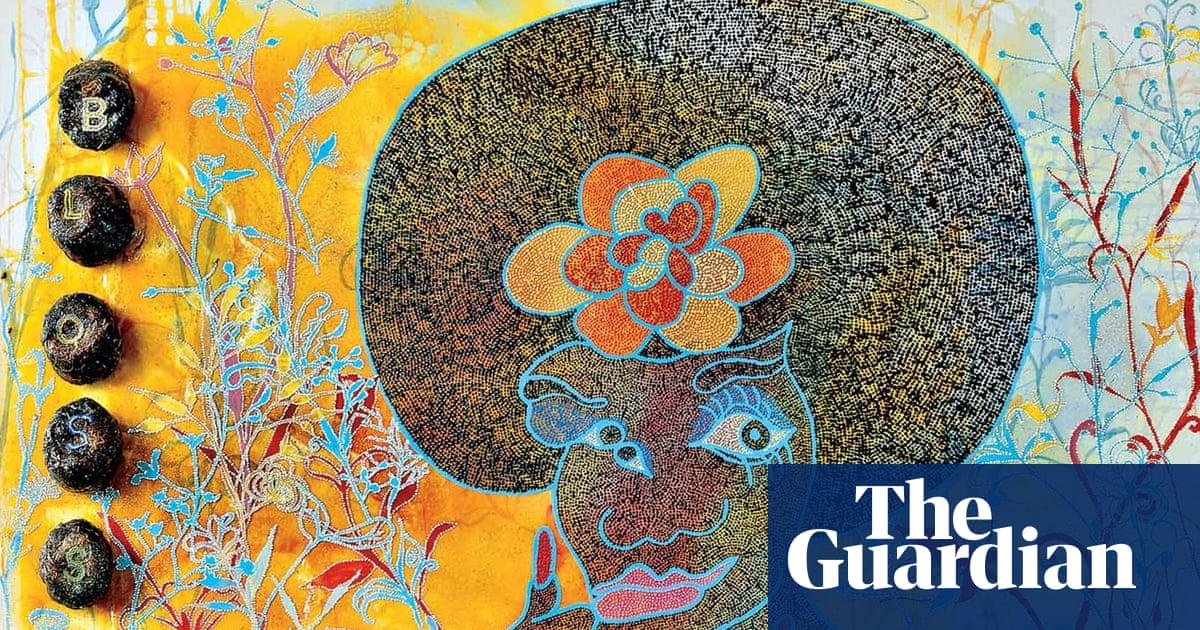An important work by the Turner prize-winning British artist Chris Ofili, featuring his signature use of elephant dung, will be auctioned for the first time at Christie’s in October.
Blossom (1997), a portrait created a year before Ofili became the first black artist to win the Turner prize in 1998, is estimated to sell for £1m to £1.5m. The piece blends sacred iconography with popular culture and African symbolism, using Ofili’s signature materials of glitter, resin and elephant dung.
Tessa Lord, the head of postwar and contemporary art at Christie’s London, which is selling the work on 20 October, said: “This is one of the most exciting paintings that I’ve worked with in a long time. Ofili’s works are large-scale works that are rare to auction.”
Ofili’s painting will come under the hammer alongside four works by the Scottish painter Peter Doig, which will also be offered at auction for the first time: Ski Jacket, Country Rock, Concrete Cabin and Yara. Other notable works in the collection include 1981-82 by Jean-Michel Basquiat and Hon (She) by the Danish artist Karin Mamma Andersson.
Ofili was born in Manchester and is of Nigerian descent. He studied at the Chelsea College of Arts and the Royal College of Art. In 2003, Ofili represented Britain at the Venice Biennale. He is based between London, New York and Trinidad.
Blossom was exhibited in 2010 as part of Ofili’s mid-career retrospective at Tate Britain, the most extensive display of his work to date. It was also included in the 2014-15 survey at the New Museum in New York.
The painting draws upon traditional ideas of the mother and child, depicting a woman with an exposed breast, crowned by an orange flower placed in her afro. On the left-hand side, the painting’s title, Blossom, is vertically spelled out, inscribed into spheres of elephant dung.
“The surface is extraordinary,” said Lord. “It’s got these almost pointillist textured dots all over the surface and resin that creates these layers that are really, in person, quite beautiful.”
after newsletter promotion
The piece is from an “important year” in the artist’s career, said Lord. Ofili’s 1997 solo exhibition, which showcased in the Southampton City Art Gallery, the Serpentine Gallery in London and the Whitworth Art Gallery in Manchester, “cemented his nomination on to the Turner Prize in 1998, which he won”.
As well as being the first black artist to win the prize, Ofili was the first painter in more than a decade to win the award. “Previously it had been quite conceptual, so Ofili really represents the strength of British painting in that 90s, early 2000s moment.”
The collection is owned by Ole Faarup, a late Danish design entrepreneur and philanthropist who acquired Blossom in 1997. The entire collection was assembled over a period of 50 years. All proceeds will go to the Ole Faarup Art Foundation, which aims to support young Danish artists by placing their works in museums around the world.
“The masterpieces in the collection are the works by two British artists,” said Lord. Ofili and Doig had a “personal connection”. Having first met as students at Chelsea College of Arts, Doig would later stay with Ofili in Trinidad in the early 2000s, an experience that inspired the work Yara, which is up for auction in the collection.
Ofili’s style is often considered “punk art” and is influenced by artists such as Jean-Michel Basquiat and Philip Guston. His work has garnered attention for its brazenness and provocation, particularly for the frequent use of elephant dung and pornographic imagery.
His painting The Holy Virgin Mary attracted controversy in 1998 for its depiction of a Black Madonna surrounded by images from blaxploitation films and pornographic magazines. It was sold for £2.9m at Christie’s.
“We really haven’t had something like this or a work of this quality since 2015 when we sold The Holy Virgin Mary,” said Lord.
